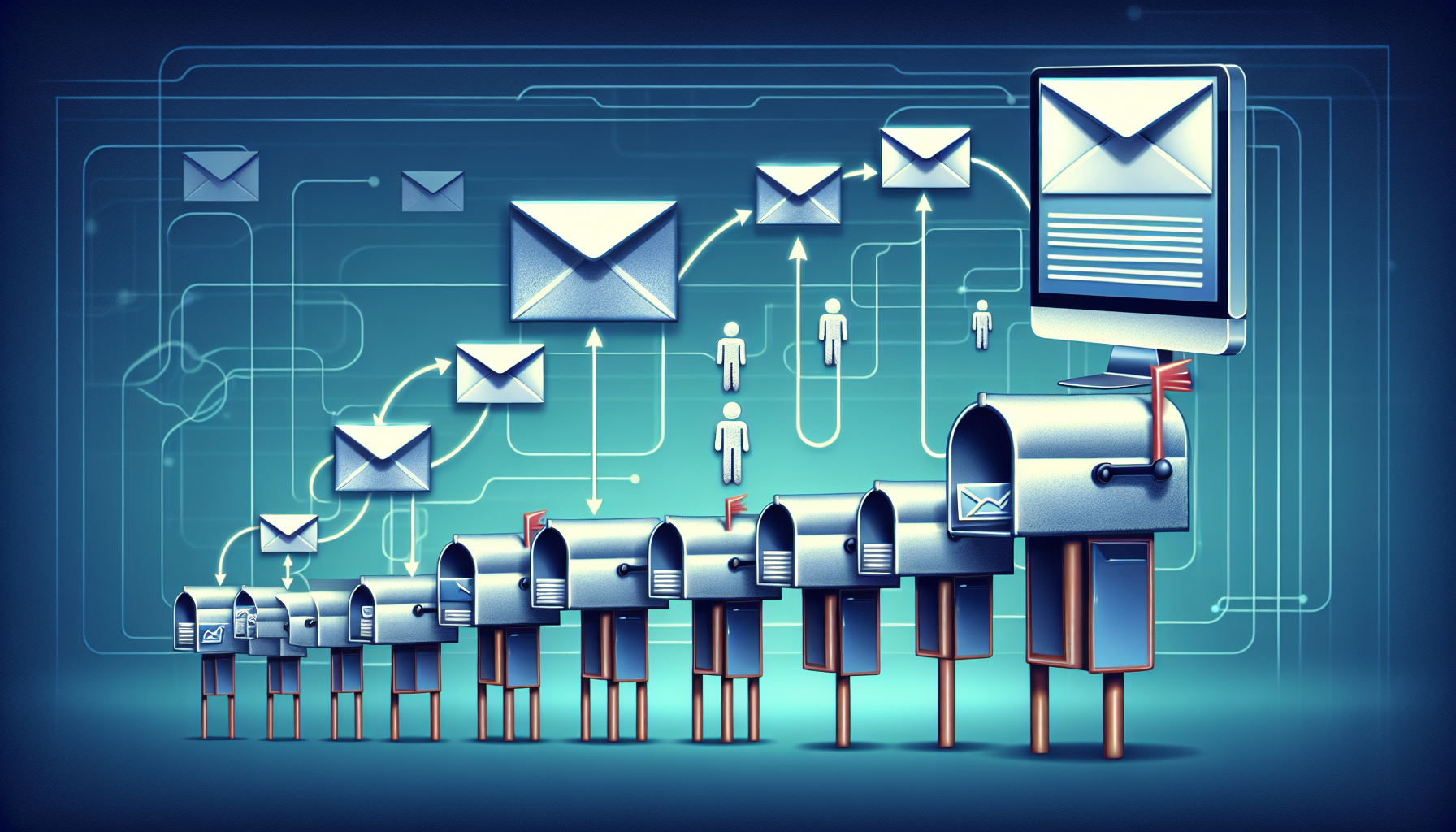Mastering Lead Follow Up Systems: Top Strategies and Tools
Please note, this article contains affiliate links that we do get paid on
Struggling to follow up on leads? Lead follow up systems are your solution to stay connected with prospects, improve lead nurturing, and boost conversion rates. This article covers top strategies, crucial tools, and practical steps to optimize your lead follow up process.
Key Takeaways
Implementing efficient lead follow-up systems, including automation and CRM integration, is crucial for capturing, qualifying, and transforming leads into sales opportunities.
Choosing the right lead follow-up software, with features like email automation, CRM compatibility, and customizable sequences, significantly enhances the effectiveness of follow-up processes.
Personalized and segmented follow-up strategies, combined with multi-channel approaches and consistent follow-up efforts, can considerably improve engagement and conversion rates.
Utilizing lead scoring is essential for improving conversion rates by prioritizing high-potential leads.
Ensuring visibility of the sales pipeline is vital for tracking customer journeys and optimizing sales strategies.
Understanding Lead Follow Up Systems
Sales reps employ a lead follow-up system, a critical collection of processes and tools, to keep in touch with leads, engage them and guide them through the sales funnel. The main objective is to nudge these prospects into making a purchase and focus on lead nurturing. This task becomes critical given that a mere 2% of sales occur during the time consuming the first contact. This means that without consistent follow-ups, businesses risk missing out on 98% of potential sales opportunities.
Thus, efficient lead follow-up systems are indispensable in capturing, qualifying, and transforming leads into fruitful business opportunities. Effective follow-up systems can significantly improve conversion rates.
Key Components of a Lead Follow Up System
Several key components form the backbone of a robust lead follow-up system. First and foremost, automation plays a pivotal role. Automating follow-ups enables businesses to save considerable time and cut down on manual labor, freeing sales teams to concentrate on strategic tasks. Automation encompasses automated lead collection, segmentation, and nurturing, ensuring that leads are managed efficiently and consistently.
Another cornerstone is the integration with Customer Relationship Management (CRM) systems. A properly integrated CRM system organizes sales leads, automates communications and tracks all lead information and interactions on a unified platform. This integration is often facilitated through web forms that capture lead information and connect it to the CRM, enabling precise segmentation and personalized email campaigns.
Additionally, effective lead management software includes tools for:
Qualification
Nurturing
Scoring
Routing
Success measurement
Lead scoring
These tools not only help in following up but also in capturing and segmenting leads, thereby enhancing the overall efficiency of the sales process.
Visibility in the sales pipeline is crucial for tracking customer journeys, ensuring that no lead is overlooked and that each potential customer receives the appropriate attention at every stage.
Benefits of Implementing a Lead Follow Up System
Implementing a lead follow-up system offers numerous benefits that can significantly impact a business’s bottom line. One of the primary advantages is the reduction in overhead costs. Marketing automation software, like Keap, eliminates the manual work involved in following up, freeing up employee time for more valuable tasks and ensuring a level of consistency that is nearly impossible to achieve manually.
Moreover, automated lead follow-up systems offer the following benefits:
Reduce human errors by following predefined tasks, ensuring no missed connections
Save time and increase efficiency
Improve accuracy of the follow-up process
Generate more sales opportunities
Increase conversion rates
Additionally, lead nurturing can generate more sales opportunities by building stronger relationships with potential customers over time.
Automated follow-up systems can also improve conversion rates by ensuring timely and consistent communication with leads.
Choosing the Right Lead Follow Up Software
Choosing suitable lead follow-up software is pivotal to constructing an efficient follow-up system. Desirable software should feature:
Compatibility with CRM
Comprehensive contact history
Lead scoring to prioritize potential customers
Visibility of the sales pipeline for tracking customer journeys
Popular tools in the market, such as Pipedrive, Zoho CRM, Apollo.io and Mailchimp, provide various functionalities to tailor your follow-up system to your specific needs.
Top Features to Look For
Several features should take precedence when selecting lead follow-up software. Email automation is key, as it allows timely follow-ups without manual intervention, boosting productivity and engagement. CRM compatibility is equally important, enabling seamless integration with other business tools and enhancing communication efficiency through resources like customized email templates.
Customizable follow-up sequences are essential for tailoring interactions based on lead behavior, ensuring more personalized and effective communication. Visibility of all important points in the sales pipeline is fundamental for tracking customer journeys and timing follow-up actions accurately, while a comprehensive contact history equips you with the necessary context for well-informed follow up sequence activities.
Lead scoring is another critical feature to look for, as it helps prioritize leads based on their potential value, ensuring that your team focuses on the most promising prospects.
Lastly, a comprehensive lead follow-up software should include features that allow tracking and managing leads efficiently through various stages of the sales funnel. This holistic approach ensures that no lead is neglected, and every interaction is optimized for maximum conversion.
Popular Lead Follow Up Tools
Several lead follow-up tools have gained popularity for their robust features and user-friendly interfaces. Zoho CRM, for instance, combines multi-channel communications, including sales, marketing, help desk, and social, into one platform. Brevo stands out for its ability to automate messaging across email, SMS, chat, and WhatsApp, providing a comprehensive communication solution.
Tools like Apollo.io, Mailchimp and Pipedrive can aid in lead nurturing, helping to build and maintain relationships with potential customers. These tools can also improve conversion rates by ensuring timely and relevant follow-ups.
Some tools for automating your email marketing workflows and lead generation are:
Apollo.io: offers email outreach sequences and data to power outreach
Mailchimp: offers a range of automation templates to kickstart email workflows
LeadBooster by Pipedrive: includes components like Chatbot, Live Chat, Web Forms, and Prospector, offering a comprehensive toolkit for lead generation
Mailshake: enables automated email sending based on specific events, such as downloading a white paper or viewing a product, ensuring timely and relevant follow-ups.
Automating Your Follow Up Emails
Automation of follow-up emails revolutionizes the sales process, making it easier to automate follow up emails. By using automated emails, it keeps your brand in front of potential customers, increases response rates, and saves valuable time for your sales team with automatic follow ups. Automated follow-up emails also contribute significantly to lead nurturing, ensuring that prospects are consistently engaged.
Tools like Mailshake and Keap make it easy to set up automated follow-ups, ensuring that your messages reach prospects at the right time and with the right content. Additionally, automation can improve conversion rates by delivering timely and relevant messages that encourage prospects to take action.
Setting Up Automated Follow Up Emails
Setting up automated follow-up emails involves using tools like Mailshake, Keap, and Pipedrive to create personalized campaigns, schedule reminders for tasks, and add automatic follow ups. Automation allows for consistent and timely follow-ups, increasing response rates and keeping your brand top of mind for potential customers. Mailshake, for example, enables users to create custom follow-up sequences that are triggered based on specific actions, such as a lead downloading a white paper or viewing a product on your site.
Keap’s CRM and sales and marketing automation software enables you to quickly establish lead follow-up automation, preventing any leads from being neglected. This ensures that every lead is promptly and efficiently addressed. Campaigns by Pipedrive offer customizable email templates to capture leads’ attention and track engagement, streamlining the follow-up process. By scheduling reminders for follow-up tasks, you can ensure that no lead nurturing activity is missed, maintaining consistency in your follow-ups. Setting up automated follow-up emails aids in lead nurturing by providing timely and relevant content to prospects.
The purpose of a long-term nurture campaign is to provide consistent and personalized follow-up to prospects, building better business habits and increasing the likelihood of conversion. Automation enables you to shift your focus to other important aspects of your business while ensuring that your follow-up strategy remains effective and efficient. This setup can significantly improve conversion rates by maintaining engagement and moving leads through the sales funnel.
Best Practices for Follow Up Email Sequences
There are several best practices involved in crafting efficient follow-up email sequences. Firstly, it’s recommended to space out follow-up attempts and limit the number of follow-up emails to 3-4 to avoid overwhelming the prospect. Starting with a welcome email can set the tone for future communications, introducing the prospect to your brand and setting clear expectations.
Best practices in follow-up email sequences contribute significantly to lead nurturing, ensuring that prospects are guided smoothly through the sales funnel. Each follow-up email should offer escalating value propositions, providing new information or offers that gradually increase the prospect’s interest and engagement. Personalizing each message by referencing past interactions or addressing specific needs can significantly improve response rates and customer engagement. These practices can also improve conversion rates, turning more prospects into customers.
Personalizing Your Follow Up Strategy
It’s imperative to personalize your follow-up strategy to boost engagement, convert leads, and drive sales. Personalized email follow-ups can build stronger relationships with subscribers, leading to higher open rates, click-through rates, and conversion rates. Personalized follow-ups also contribute significantly to lead nurturing by maintaining consistent and relevant communication.
Personalized follow-ups, reflecting specific interests and preferences, make prospects feel appreciated and acknowledged, which can improve conversion rates.
Segmenting Leads for Targeted Follow Ups
To segment leads for targeted follow-ups, you need to categorize your audience based on certain criteria like:
demographics
geographic location
psychographics
behavior
firmographics
Market segmentation allows for building targeted email campaigns by dividing audiences based on specific data. For example, demographic segmentation targets leads based on factors like age, gender, and income level, while geographic segmentation focuses on location.
Psychographic segmentation divides leads based on lifestyle, values, and interests, ensuring that messages resonate on a personal level. Behavioral segmentation targets leads based on actions taken, such as browsing history or purchase behavior, allowing for highly relevant follow-ups. Firmographic segmentation categorizes leads based on company attributes, like industry and size, which is particularly useful in B2B contexts.
Segmenting leads aids in lead nurturing by delivering more relevant content to each segment, fostering stronger relationships over time. Additionally, segmentation can improve conversion rates by ensuring that marketing efforts are more precisely targeted, increasing the likelihood of turning leads into customers.
Including relevant product recommendations based on past behavior can increase the effectiveness of follow-up emails, making them more personalized and engaging. By tying a long-term nurture campaign with a CRM system, you can track prospect interactions, score leads higher as they take desired actions, and prioritize who is ready for a personalized follow-up.
Crafting Personalized Follow Up Messages
To craft personalized follow-up messages, you need to utilize subscriber data, reference past interactions and introduce new value in each message. Segmenting your email list based on location, purchase history, or interests allows for more targeted and relevant messages, enhancing engagement and reducing unsubscribe rates. For instance, using the subscriber’s name in the greeting and referencing their past purchase history can make follow-up messages feel more personal and tailored.
Personalizing follow-ups by addressing specific needs and mentioning details about the prospect’s own business model can significantly increase sales success. Each follow-up message should aim to provide new value or information, reinforcing your commitment to the lead’s success and encouraging further engagement. Personalized messages contribute to lead nurturing by building stronger relationships with prospects. Additionally, personalization can improve conversion rates by making the communication more relevant and compelling.
Integrating Follow Up Systems with Your CRM
The integration of follow-up systems with your CRM can enhance customer-business relationships, boost sales, and augment productivity. It allows for the centralization of customer information, such as demographics and purchase records, ensuring that all follow-up actions are informed and relevant. Additionally, CRM integration aids in lead nurturing by providing timely and personalized follow-ups.
This integration also facilitates automatic updates to CRM data triggered by specific events, which cuts down on manual labor and enhances efficiency. Moreover, such integration can improve conversion rates by ensuring that potential leads are consistently and effectively managed throughout the sales process.
Benefits of CRM Integration
The integration of follow-up systems with a CRM comes with multiple benefits. One of the most significant advantages is the centralization of customer information. A CRM integrated with follow-up systems ensures that the latest email correspondences are saved and filed under the appropriate contact profiles, making it easier for sales teams to track interactions and maintain a comprehensive view of each lead. This centralization reduces the time spent searching for information and allows for more focused and effective follow-ups.
Another key benefit of CRM integration is the automation of repetitive tasks. This automation streamlines the follow-up process, ensuring no lead is neglected and improving overall team productivity. Some examples of repetitive tasks that can be automated include:
Sending follow-up emails to leads
Updating contact information in the CRM
Scheduling follow-up calls or meetings
Assigning tasks to team members
CRM integration also significantly benefits lead nurturing by providing timely and personalized follow-ups, which can help build stronger relationships with potential customers.
By automating these tasks, marketing and sales teams can focus on higher-value tasks instead of routine updates. This can help shorten the sales cycle and lead to increased conversions and significant business growth. For example, ClientTether’s CRM software helped Painter1 effectively manage leads, leading to more sales goals, increased conversions and significant business growth.
Improved customer satisfaction is also a major benefit of CRM integration. By responding more quickly and accurately to customer needs, businesses can enhance their relationships with prospects and customers. This leads to higher conversion rates and better customer retention. Tools like Mailshake integrate seamlessly with CRM systems, allowing for smooth management of follow-up email campaigns.
Top CRM Tools for Follow Up Automation
Numerous CRM tools are noteworthy for their competencies in follow-up automation. Odoo CRM is recognized for its robust solutions tailored to businesses of various sizes, offering a comprehensive suite of tools for customer follow-up. HubSpot CRM excels in automating different actions, based on how contacts interact with emails, such as sending another marketing email or adding a contact to a specific list. Tools like HubSpot CRM aid in lead nurturing by automating personalized follow-ups, which can significantly improve conversion rates.
Some top choices for marketing automation platform tools are:
HubSpot: More pricey than others, but provides a more holistic suite of tools and integrations making it more cost effective in the long run, plus offers visualisations and extensive triggers for automations too
ActiveCampaign: known for its extensive triggers and actions that automate tasks like sending follow-up emails or updating custom deal fields
EngageBay: offers features like visual automations and kanban board-style interfaces for tracking tasks and calling contacts directly from the platform
Pipedrive: provides a visual sales pipeline and unique automation settings, allowing for greater control over execution and mapping contacts geographically. Integrations with tools like Slack and Zoom further enhance its functionality.
Case Studies: Success Stories with Lead Follow Up Systems
Real-world examples of businesses that have triumphed in implementing lead follow-up systems can offer valuable insights and serve as an inspiration. From small businesses to large enterprises, these case studies highlight the transformative impact of effective follow-up strategies on sales and growth. Successful case studies demonstrate the importance of lead nurturing and show significant improvements in conversion rates.
Small Business Success Story
Intent91, a small UK-based personal training company, showcases the power of automated follow-up emails and targeted advertising. By investing a minimal amount in Facebook ads and focusing on educational and customer testimonial content, Intent91 was able to generate more leads effectively and efficiently. The use of automated follow-up emails allowed Intent91 to promptly respond and engage with leads, providing personalized responses that increased their sales conversion rates.
Intent91's strategy included lead nurturing, which played a crucial role in maintaining engagement with potential clients. This approach significantly improved their conversion rates, turning more leads into paying customers.
This strategy not only streamlined their follow-up process but also ensured that potential customers received timely and relevant communications, enhancing their overall experience with the brand. The success of Intent91 demonstrates how even small businesses can achieve significant results with the right follow-up systems and strategies.
Enterprise Success Story
Painter1, a large painting franchise, leveraged ClientTether’s automated follow-up system to handle high volumes of leads, resulting in higher appointment scheduling rates and increased revenue from repeat business and referrals. By implementing ClientTether’s lead response automation, Painter1’s franchisees were able to schedule appointments more swiftly than competitors, ensuring no lead was neglected. Painter1's strategy also included lead nurturing, which played a crucial role in their success.
This automated system allowed Painter1 to maintain a high level of consistency and efficiency across their franchise network, leading to significant business growth and improved conversion rates. BMC Software provides another compelling example, achieving a 49.5% conversion rate by targeting high-quality leads from their existing database. Through a strategic B2B lead generation approach, BMC Software effectively converted 5,000 leads and increased their Marketing Qualified Leads (MQLs) by over 2,500.
These enterprise success stories underscore the importance of investing in automated follow-up systems to manage large volumes of leads and drive substantial revenue growth.
Overcoming Common Challenges in Lead Follow Up
Lead follow-up systems, while laden with numerous benefits, do come with their set of challenges. Common issues include dealing with non-responsive leads and maintaining consistency across sales team members.
Addressing these challenges aids in lead nurturing by ensuring that potential customers are consistently engaged. Overcoming these challenges can also improve conversion rates, making it imperative to address them to guarantee an effective follow-up strategy.
Dealing with Non-Responsive Leads
Non-responsive leads can be a significant hurdle in the follow-up process. One effective strategy is to reference details from previous interactions to show care and personalize the message. Personalized messages aid in lead nurturing by re-engaging leads, reminding them of their initial interest, and demonstrating that they matter and you value their business.
Persistence is also key. After the first meeting, it is recommended to call at least five times for effective sales follow-up. This consistent effort increases the chances of eventually making contact and moving the lead further down the sales funnel, thereby improving conversion rates.
Maintaining Consistency in Follow Ups
Maintaining consistency in follow-ups is essential for ensuring that every lead receives the same level of attention and effort. Establishing a standardized follow-up process for the sales team can help achieve this goal. This process should outline the frequency and content of follow-ups, ensuring a uniform approach across all team members. A standardized process also aids in lead nurturing by providing a clear framework for engaging with potential customers.
Consistent follow-ups are crucial because 80% of sales require five follow-up calls after the initial meeting. By adhering to a standardized process, sales teams can ensure that no lead is neglected and that follow-up efforts remain steady and effective. Consistency in follow-ups can significantly improve conversion rates by maintaining regular contact and building trust with leads.
Maximizing Sales Opportunities with Follow Up Systems
To maximize sales opportunities with follow-up systems, it’s essential to leverage analytics for enhancing follow-up effectiveness and adopt multi-channel approaches. Analytics aid in lead nurturing by providing insights into customer behavior and preferences. These strategies can significantly increase productivity and enhance the reach and impact of your follow-up efforts. Additionally, a multi-channel approach can improve conversion rates by engaging customers through various platforms.
Using Analytics to Improve Follow Up Effectiveness
Analytics hold a crucial role in fine-tuning follow-up strategies. Sales follow-up software often includes analytics tools that measure the effectiveness of different follow-up approaches, allowing for data-driven improvements. By tracking interactions and adjusting follow-up strategies based on prospect engagement, businesses can make their follow-ups more effective.
Analytics also aid in lead nurturing by providing insights into customer behavior and preferences. Tracking conversion rates is crucial as consistent follow-ups help nurture leads through the sales funnel. For example, response rates can increase by 18% by the third follow-up email, highlighting the importance of persistence and well-timed follow-ups. Data-driven improvements can significantly enhance conversion rates, ensuring that follow-up efforts are both efficient and effective.
Enhancing Follow Ups with Multi-Channel Approaches
Adopting a multi-channel approach can notably broaden the reach and boost the effectiveness of follow-up efforts. Combining the following channels ensures comprehensive and diversified follow-up strategies:
Emails
Phone calls
Social media messages
Direct mail
Multi-channel approaches aid in lead nurturing by maintaining consistent and personalized communication across different platforms. This consistency helps build trust and keeps leads engaged throughout the sales process.
For instance, Cornerstone OnDemand saw a 274% ROI and gained 2,837 MQLs by investing in a multi-channel marketing campaign, including Google, LinkedIn, and programmatic ads.
Sales follow-ups can include multiple channels such as:
Emails
Calls
SMS
Social media
These approaches can improve conversion rates by reaching leads through their preferred communication channels, increasing the likelihood of a positive response.
These channels help keep communication alive and effective. Text messages offer a convenient way to communicate with leads, providing quick reminders and updates, while social media platforms like LinkedIn and Twitter allow for more interactive engagement. In-person follow-ups through meetings or networking events enable deeper connections and effective addressing of prospect needs.
The recommended time frame for sending text messages to leads is between 8 am and 9 pm local time each week, with 90% of text messages being read within three minutes. This immediacy makes text messaging a highly effective communication channel.
Summary
In summary, mastering lead follow-up systems involves understanding their key components, choosing the right software, automating follow-up emails, personalizing follow-up strategies, and integrating these systems with your CRM. These steps help increase efficiency, reduce manual work, and enhance customer relationships.
Lead nurturing is crucial as it builds strong relationships with potential customers, guiding them through the sales funnel. By implementing the strategies and tools discussed in this guide, businesses can significantly improve their follow-up processes, boost conversion rates, convert more leads, and maximize sales opportunities. The journey to mastering lead follow-up systems is continuous, but with the right approach, it can lead to substantial growth and success.
Frequently Asked Questions
What is a lead follow-up system?
A lead follow-up system is designed to help sales representatives stay in touch with leads and keep them interested in the sales process, ultimately guiding them towards a purchase. Lead nurturing is a key component of a lead follow-up system. These systems can significantly improve conversion rates.
Why is automation important in lead follow-up systems?
Automation is important in lead follow-up systems because it saves time, reduces manual effort, ensures timely follow-ups, increases response rates, and maintains consistency, ultimately allowing sales teams to focus on strategic tasks. Additionally, automation aids in lead nurturing by providing personalized and timely communication. It can also improve conversion rates by ensuring that leads are engaged and followed up with at the right moments.
How can CRM integration benefit my lead follow-up system?
Integrating CRM can benefit your lead follow-up system by centralizing customer information, reducing manual work, improving customer satisfaction, and increasing conversions. CRM integration aids in lead nurturing by providing personalized and timely interactions with potential customers. This leads to informed and relevant follow-up actions, resulting in shorter sales cycles and higher productivity. Additionally, integration can improve conversion rates by streamlining the sales process and ensuring no lead is overlooked.
What are some popular lead follow-up tools?
Some popular lead follow-up tools are Zoho CRM, Brevo, Mailchimp, LeadBooster by Pipedrive, and Mailshake. They provide features such as email automation, multi-channel communications, and customizable follow-up sequences. Tools like Zoho CRM aid in lead nurturing and can significantly improve conversion rates.
How do I deal with non-responsive leads?
To deal more deals with non-responsive leads, personalize your message by referencing details from previous interactions and be persistent with multiple follow-up attempts to increase the chances of re-engaging the lead. Personalized messages aid in lead nurturing by building stronger relationships with potential clients. Additionally, persistence can improve conversion rates by ensuring that you stay top-of-mind with your leads. This approach can help you improve lead responsiveness and engagement significantly.





